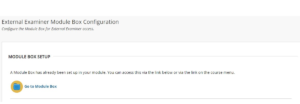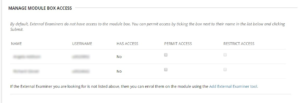The following will provide you with information and guidance on how to provide material to External Examiners for modules using the Blackboard VLE (via the Electronic Module Box) and the TU Online VLE (using the university’s SendTo service).
The Blackboard Electronic Module Box
Every Blackboard module has a content area called Module Box. This area is designed to contain (or link to) the information needed by the External Examiner.
By default, the Module Box area is not visible to External Examiners (nor is it visible to students).
It is the responsibility of the Module Leader to first populate the Module Box content area with appropriate material and then make it available to External Examiners when required.
This article was updated in October 2020 to take into account changes in the Module Box setup.
Blackboard Module Box Checklist
The first task is to populate the Module Box with the material to be made available to the External Examiner.
This checklist of materials is standardised across the University and is approved by the External Examiner Sub-committee.
Populating the Module Box is the responsibility of the Module Leader
The default Module Box comes in the form of a standardised template which Module Leaders are asked to complete with material as appropriate.
The areas are:
- Internal Moderation Pack
- Sample of ICA Work & Feedback
- Additional Information
In more detail:
1. Internal Moderation Pack
This folder should contain the Internal Moderation Pack. The aim of this pack is to provide guidance on the process of internal moderation and documentation that must be completed to evidence that due process has been followed and to demonstrate to External Examiners what processes have been followed.
An Internal Moderation Pack must be completed for each assessment component.
A separate pack should be completed for reassessments.
The pack should contain:
- Assessment Report – this is to be completed by the Module Leader following completion of marking and moderation processes and it gives details about the module, its assessment and the process used for internal moderation.
- Internal Sampling Report – this is to be completed by the Internal Sampler where internal sampling has taken place.
- Record of Double Marking – to be completed by the Module Leader when double marking has taken place.
- Record of Checking Process – to be completed where assessments comprise solely of objective tools (e.g. Multiple Choice Questions, objective right and wrong answers) to replace the Internal Sampling Report. This record should identify the process of checking by a second person to ensure that marks have been calculated and recorded accurately.
- Exam Papers & Marking Schemes – where relevant (and not contained elsewhere in the module).
You should also upload a School-specific marks sheet which must:
- Include the name of each student and their agreed mark in an appropriate format (E.g. percentage, Pass / Fail, Pass / Merit / Distinction)
- Demonstrate component marks (where appropriate)
- Indicate which work has been internally sampled by placing a tick in the IS column or annotation next to the name
- Indicate which work has been included in the External Examiners sample by placing a tick in the EE column or annotation next to the name
2. Sample of ICA Work & Feedback
This folder should contain 10 ICAs (for modules with fewer than 10 students, then the work of all students) as a sample for the External Examiner.
- The sample must include work across all boundaries.
- The sample can include work that has been internally moderated, but does not have to be restricted by this.
- Ask the External to look at any student work where the student has raised issues with the marking etc. This helps with assessment reviews/complaints.
The folder also contains a link to the My Grades tool which provides the External Examiner with access to all electronically submitted assignments and related feedback.
If you choose to make the samples of student work available through My Grades (rather than uploading them separately to this folder), please remember to identify which work has been selected for the sample either by indicating on the mark sheet in the Internal Moderation Pack, or attaching a list of student names in this folder.
To re-create a link to My Grades, if required:
- Select Tools > More Tools > My Grades.
- Click Submit.
3. Additional Information (as appropriate)
This folder should be used to store any additional information that you may wish to provide to the External Examiner which does not fall into any of the above areas. Some suggestions for additional information include:
- Link to UTREG Online Module Specification
- Assessment Board Schedules
- Module Variances
- List of relevant School contacts
- Course Structure (I.e. where the module fits into the broader course structure)
- The Module Guide and other student facing documentation should already be made available in the student accessible parts of the Blackboard module.
Making the Module Box Available to External Examiners
Module Leaders can do this using the Configure Module Box tool. This adds an extra layer of security to the Module Box area and ensures that the correct External Examiners are provided with access when needed.
The following instructions explain how to permit and restrict access to the Module Box:
1. Firstly, ensure the External Examiner(s) is / are enrolled on your Blackboard
Module. You can do this through the User and Groups > Users area in the module Control Panel.
External Examiners must always be enrolled with the “External Examiner” role. This is an essential part in ensuring the tool works correctly.
In most cases, External Examiners will be enrolled on your module automatically via the data uploads from SITS. If not, Module Leaders can enrol External Examiners manually using the Add Module Leaders > Add External Examiners tool in the module Control Panel.
If the External Examiner is enrolled with an incorrect role (e.g. Module Leader), simply remove them from the module using the Remove Module Leaders tool in the Control Panel and then proceed as above. In case of difficulty, please contact elearning@tees.ac.uk.
2. When you are ready to release the Module Box to the External Examiner(s), go to Control Panel > Course Tools > Configure Module Box.
3. The configuration tool contains two sections: Module Box Setup and Manage Module Box Access.
The Module Box Setup section will display a link to the electronic Module Box area providing it exists and has been setup correctly. By default, all modules should already contain a Module Box area. However, if you do not see a link, then you will need to use this section to create the Module Box.

4. Providing your External Examiners have been enrolled on the module with the correct role, you should see them listed in the Manage Module Box Access section of the configuration tool. By default, External Examiners should not have access to the Module Box, so you should see “No” listed in the “Has Access” column.
5. To permit access, check the box in the “Permit Access” column next to the External Examiner(s) that you want to provide with access. Click Submit to save your changes. After permitting access, the External Examiner will be able to see the “Module Box” item on the course menu and access it.
6. Similarly, to restrict access, check the box in the “Restrict Access” column and click Submit.

TU Online SendTo
The TU Online VLE does not as yet support Electronic Module Boxes, so in the interim, Module Leaders are asked to use SendTo to send a package of files to the external examiner.
First, please assemble a folder of content for the External Examiner. It should contain the same materials as listed in the Blackboard Module Box Checklist. Clearly, where the Blackboard Checklist suggests you link directly to the materials inside the VLE, for TU Online you will need to include actual copies of the material in the folder sent to the External Examiner.
When you have populated your folder, use 7-Zip to create an encrypted copy of your folder as a single file.
ANY INFORMATION SENT TO THE EXTERNAL EXAMINER MUST BE ENCRYPTED BEFORE BEING SENT AS PER THE UNIVERSITY INFORMATION SECURITY POLICY.
For more information on how to this, please see:
or contact ithelp@tees.ac.uk.
The documentation refers to encrypting a single file, but works just the same for your folder of materials for the External Examiner.
ALWAYS SEND THE PASSWORD SEPARATELY TO THE ENCRYPTED FOLDER (perhaps by phone, certainly in a different email).
Once the folder is encrypted, you can use SendTo to get the encrypted single file to the External Examiner.
SendTo is a system that allows you to send files to people outside the University that are larger than the normal email system allows.
For more information on how to use SendTo, please see:
https://extra.tees.ac.uk/HelpCentre/SelfHelp/Documents/How%20do%20I%20use%20SendTo.pdf
or contact ithelp@tees.ac.uk.
